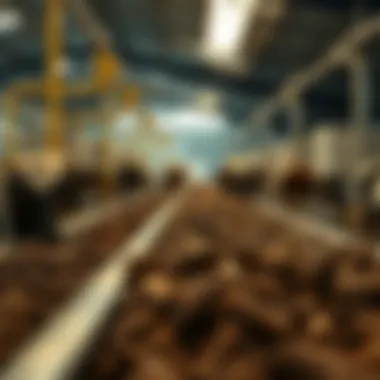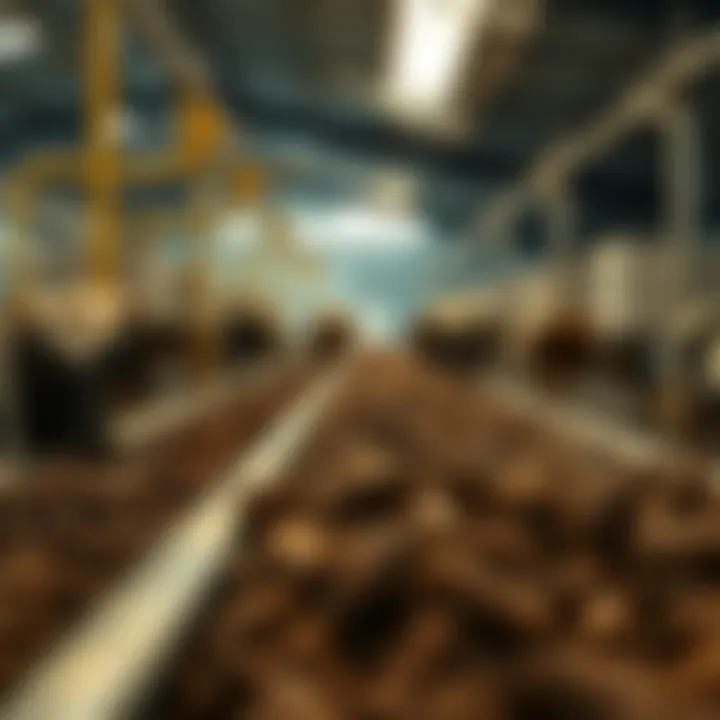Harnessing Methane from Cow Manure for Sustainable Energy


Overview of Research Topic
The transformation of animal waste into valuable energy source is significantly reshaping perspectives in sustainable agriculture and energy production. Cow manure, often regarded as a mere agricultural by-product, holds potential that extends well beyond its conventional uses. Through a process called anaerobic digestion, methane can be extracted from this organic material, leading to the production of biogas. This presents a unique solution to two pressing issues: the management of livestock waste and the need for renewable energy sources.
In recent years, the world has taken heed of the environmental consequences posed by traditional energy production methods. As the urgency for sustainable practices grows, alternative energy solutions like biogas are gaining traction. The science behind this transition is intricate and fascinating. Understanding how methane is harnessed from cow manure not only informs the scientific community but also offers practical applications for farmers and businesses alike.
Brief Background and Context
Agricultural waste management has been a topic of interest for decades. Initially, manure was simply spread on fields as fertilizer. However, with increasing concerns around greenhouse gases and waste management, researchers began exploring the gas production potential of this organic material.
Biogas, a mixture primarily composed of methane and carbon dioxide, is produced when microorganisms break down organic matter in the absence of oxygen. This process occurs in several stages, involving hydrolysis, acidogenesis, acetogenesis, and methanogenesis. Each of these steps plays a pivotal role in converting cow manure into usable energy.
Importance in Current Scientific Landscape
The exploration of biogas from cow manure carries significant implications.
- Environmental Benefits: The use of biogas reduces methane emissions from manure, contributing to a decrease in global warming potential.
- Energy Independence: Utilizing waste for energy generation can help reduce dependency on fossil fuels, promoting energy self-sufficiency.
- Economic Opportunities: Farmers can benefit financially by utilizing biogas systems, making waste management practices more viable and sustainable.
- Nutrient Recycling: The by-products of anaerobic digestion can enrich soil, thus supporting sustainable farming practices.
"Harnessing biogas from cow manure not only aids in sustainable practices but aligns agriculture with the fight against climate change."
Methodology
Understanding how cow manure is transformed into biogas requires a careful examination of the biochemical processes involved.
Research Design and Approach
Most studies focusing on this transformation utilize experimental setups that closely replicate the conditions of anaerobic digesters. By isolating microorganisms from manure samples and monitoring their activity, researchers can observe the breakdown of organic materials and measure methane production under various conditions.
Data Collection Techniques
Different methods can be used to analyze the efficiency and productivity of anaerobic digestion processes, including:
- Gas Chromatography: This technique is crucial for quantifying the methane content in biogas.
- Mass Spectrometry: Help researchers analyze the composition of various gases produced.
- Field Trials: Practical applications in farm settings allow for real-world data accumulation, measuring the effectiveness of biogas systems.
By dissecting these methods, scientists can optimize anaerobic digestion processes, making biogas production more efficient and accessible to farmers across the globe.
For more information on anaerobic digestion and its processes, visit Wikipedia or the US Department of Energy.
As research progresses, integrating such sustainable practices becomes essential for future agricultural and energy goals.
Prelude to Gas from Cow Manure
Gas derived from cow manure is gaining traction as a relevant topic in our contemporary conversations around energy sustainability. As the global energy crisis pushes the search for cleaner alternatives, understanding how cow manure can be transformed into biogas serves as a beacon of hope. This section of the article recognizes not only the environmental implications but also the economic and social benefits associated with this innovative approach.
Historical Background
Historically, manure was often managed through conventional means, primarily as a soil amendment. Those practices can be dated back to the days when farmers relied heavily on animal waste for enhancing soil fertility. However, the modern twist to this age-old practice emerged when the quest for renewable energy began to heat up in the late 20th century.
Biogas technology, during its inception, was often viewed as a niche solution, mainly adopted by small-scale farmers who sought to reduce waste and generate energy for on-farm usage. As time progressed, advancements in anaerobic digestion technologies significantly raised its profile. Systems became more efficient, large-scale operations emerged, and interest burgeoned on how to convert this waste into energy at a more significant scale.
This movement set the stage for biogas as a vital player in the energy landscape. Today, nearly every country is exploring the potential of cow manure to combat waste management challenges and contribute to energy security. The transformation from a traditional agricultural waste to a modern energy source marks a significant leap forward.
Current Relevance in Energy Production
The current relevance of gas from cow manure lies in its potential to reshape the energy production landscape. Amidst rising energy costs and escalating environmental concerns, this biogas presents an alternative that is both feasible and practical. Biogas not only reduces reliance on fossil fuels but also mitigates greenhouse gas emissions — a double win for sustainability advocates.
In practical terms, energy produced from cow manure has gained its place not just in rural settings but also in urban energy discussions. With the right technology in place, farms can produce significant quantities of methane, enough to power household appliances or even feed into larger grids.
As consumers become increasingly aware of their carbon footprints, the willingness to embrace energy from unconventional sources has soared. Organizations and institutions are now recognizing the synergy between agriculture and energy production, paving the way for governmental policies that promote investments in biogas infrastructure. The integration of cow manure into modern energy production isn't merely a trend; it’s a crucial component in the global agenda for sustainable development.


The Science Behind Anaerobic Digestion
Anaerobic digestion stands at the forefront of sustainable energy solutions, especially when it comes to diverting waste from agricultural sources like cow manure. This process is not just about creating energy; it is about harnessing nature's own mechanisms to improve waste management, bolster energy independence, and contribute to a cleaner environment. Understanding the science behind anaerobic digestion is crucial for those involved in energy production, agriculture, and environmental conservation.
Biochemical Process Explained
At its core, anaerobic digestion is the breakdown of organic matter without the presence of oxygen. This occurs through a series of biochemical reactions facilitated by various microorganisms. The process can be divided into four main stages:
- Hydrolysis: Organic materials are broken down into simpler sugars, amino acids, and fatty acids by enzymes.
- Acidogenesis: Acidogenic bacteria convert these simpler compounds into volatile fatty acids, hydrogen, and carbon dioxide.
- Acetogenesis: Further breakdown occurs, resulting in the production of acetic acid along with more hydrogen and carbon dioxide.
- Methanogenesis: Finally, methanogenic archaea convert acetic acid and hydrogen into methane and carbon dioxide, which can then be captured as biogas.
This sequence illustrates how cow manure morphs from mere waste into a valuable energy resource, demonstrating its potential for biogas production.
Microbial Community Involved
The efficiency of anaerobic digestion hinges significantly on the microbial community involved. This community consists of various microorganisms that thrive in anaerobic environments, each playing a unique role in the digestion process. These can be broadly classified into two groups:
- Bacteria: These serve as the primary drivers of the initial digestion stages. In particular, they are responsible for hydrolysis and acidogenesis.
- Archaea: Specifically, methanogens play a pivotal role in the final stage by converting intermediate products into methane.
A balanced and diverse microbial community is essential for optimal digestion. Factors such as pH, temperature, and carbon-to-nitrogen ratio can greatly influence the microbes’ activity and overall efficiency of the process. A healthy digester can yield a methane-rich biogas, further enhancing energy production.
Factors Affecting Digestion Efficiency
Multiple elements can influence the success of anaerobic digestion when using cow manure. Key factors include:
- Temperature: Anaerobic digestion can occur at mesophilic (around 30-40°C) or thermophilic (around 50-60°C) temperatures, with each having its own efficiency rates.
- pH Levels: The ideal pH range for anaerobic digestion typically lies between 6.5 and 8.5. Deviations can hinder microbial activity and methane production.
- Feedstock Composition: The presence of various organic materials alongside cow manure can either enhance or hinder the entire digestion process.
- Retention Time: The duration for which the manure stays in the digester impacts the amount of methane produced; longer retention usually means better breakdown and more gas.
By fine-tuning these variables, farm operators can maximize the benefits of anaerobic digestion, making it a viable energy source.
"Understanding the nuances of anaerobic digestion is essential for unlocking the full potential of cow manure as a renewable energy resource."
In summary, the science of anaerobic digestion offers profound insights into how cow manure can be effectively transformed into biogas. By grasping the biochemical processes, the vital role of microorganisms, and the various factors influencing efficiency, one can appreciate the intricacies and benefits of harnessing this powerful method of energy production.
Energy Production from Manure
The conversion of cow manure into energy is not just an innovative approach to waste management; it’s a critical component in the movement towards sustainable energy solutions. As the world grapples with climate change and the ever-increasing energy demands, harnessing manure as a renewable resource is both timely and necessary. Not only does it offer a way to reduce greenhouse gas emissions, but it also provides a source of energy that is both reliable and locally sourced.
In understanding energy production from manure, it's essential to recognize a few key elements and benefits:
- Renewable Energy Source: Cow manure can be consistently collected, providing a steady stream of organic material for conversion into biogas. This renewability is vital for creating long-term energy solutions.
- Waste Reduction: Utilizing manure for energy contributes to a reduction in waste, mitigating the environmental issues associated with large-scale livestock farming.
- Nutrient Management: Biogas systems can convert nutrients in manure, leading to enhanced nutrient recycling, which ultimately benefits soil health and agricultural productivity.
- Local Economic Development: Implementing biogas systems can stimulate local economies by creating jobs and providing young farmers with sustainable practices that lower their carbon footprint.
Methane Yields and Variability
The heart of energy production from manure lies in the methane yields generated during anaerobic digestion. However, these yields can significantly vary based on several factors:
- Feedstock Composition: Different types of manure have varying organic contents; for instance, dairy cow manure generally yields more methane than beef cattle manure due to its higher solids content.
- Digestion Conditions: Temperature, pH levels, and retention time all affect the efficiency of methane production. An optimally managed system ensures that conditions remain ideal for microbial activity.
- Microbial Health: The diversity of the microbial community plays a pivotal role in digesting organic matter effectively. A healthy, balanced community will enhance methane production.
"By tapping into the variabilities of methane yields, producers can tailor their approach for maximized energy outputs."
Conversion Technologies
Transforming cow manure into energy requires specific conversion technologies. Here are some notable methods:
- Anaerobic Digestion: This is the most common method, where microorganisms break down organic matter in the absence of oxygen, producing biogas primarily composed of methane and carbon dioxide.
- Gasification: This technology involves converting manure into syngas by high-temperature treatment in low oxygen conditions. This gas can be used for heating or further refined to produce other fuels.
- Fermentation: Some methods employ fermentation processes that utilize microorganisms to convert sugars from manure into alcohol which can subsequently be used in energy applications.
Case Studies of Successful Biogas Projects
Looking at real-world examples provides valuable insights into the benefits and challenges of biogas production from cow manure:
- The Calgren Renewable Fuels Facility in California: This biogas plant converts dairy manure to renewable natural gas, significantly reducing greenhouse gas emissions while providing clean energy to the grid.
- The New Hope Dairy Biogas Project in Virginia: This project utilizes advanced anaerobic digestion technology to convert waste into high-quality biogas, which is subsequently used for electricity generation.
- The GreenSky Renewable Energy Project in North Carolina: A community initiative that not only produces energy but also focuses on nutrient management, thus enhancing agricultural sustainability in the region.
These projects illustrate the myriad possibilities that can arise from effective management and conversion of cow manure into biogas, demonstrating a clear path towards integrating agricultural waste into the larger renewable energy framework.


Environmental Impact of Biogas Production
The production of biogas from cow manure holds significant promise for addressing various environmental challenges. It not only offers an avenue for renewable energy generation but also plays an essential role in enhancing environmental health. Understanding the implications of biogas production helps us appreciate its importance in combating climate change and enhancing soil quality. Here, we delve into specific aspects concerning the environmental impact of biogas production, particularly focusing on the reduction of greenhouse gas emissions and the benefits of nutrient recycling and soil health.
Reduction of Greenhouse Gas Emissions
One of the standout features of biogas production is its potential to significantly mitigate greenhouse gas emissions. When cow manure is left to decompose anaerobically, it releases methane, a potent greenhouse gas that contributes to climate change. However, harnessing methane through biogas systems can help keep this harmful gas in check. Instead of releasing methane into the atmosphere, biogas plants capture it and convert it into usable energy.
- Mitigation Benefits: Capturing methane offers double benefits; not only do we reduce emissions, but we also generate energy. This process curbs the need for fossil fuel consumption, creating a sustainable cycle that lowers our carbon footprint.
- Comparative Analysis: Traditional methods of manure disposal, such as open-air lagoons, result in high methane emissions. In contrast, biogas systems can reduce these emissions by about 60%-90%. This showcases a tangible solution to a pressing environmental concern.
The importance of reducing greenhouse gases cannot be overstated. The Intergovernmental Panel on Climate Change (IPCC) asserts that limiting emissions is crucial to maintaining global temperature rise below 1.5 degrees Celsius. Biogas production integrated with livestock operations can be a game changer in this endeavor.
"The transformation of waste into energy exemplifies how innovative practices can lead to both environmental responsibility and economic sustainability."
Nutrient Recycling and Soil Health
Another critical aspect of biogas production from cow manure is its role in nutrient recycling, which has a profound impact on soil health. The leftover digestate from the biogas process, rich in nutrients such as nitrogen, phosphorus, and potassium, can serve as an excellent fertilizer. This recycling of nutrients benefits the agricultural sector in several ways:
- Enhancement of Soil Fertility: By applying digestate back to the fields, farmers can improve soil structure and fertility. This practice not only sustains but also enhances crop yields over time.
- Reduced Need for Synthetic Fertilizers: Utilizing digestate reduces dependency on chemical fertilizers, which can lead to soil degradation and water pollution. Farmers converting to organic fertilization methods see cost savings as well as environmental benefits.
- Protection of Water Resources: Reducing chemical runoff is vital for protecting local water bodies from eutrophication, a process that depletes oxygen in water and harms aquatic life. Rich nutrients from manure can run off into waterways when improperly managed. The use of digestate not only curbs this but rehabilitates soils and water systems.
As society navigates the challenges posed by climate change and food security, embracing practices that enhance soil health and resource efficiency is crucial. The capacity of biogas production to contribute to nutrient recycling places it as a vital part of sustainable agricultural practices.
In summary, the environmental impacts of biogas production underscore its relevance in today’s discussions about climate change and sustainable agriculture. As we delve deeper into its benefits, it becomes clear that harnessing cow manure for energy does far more than just power homes; it sets the stage for a greener, more sustainable future.
Economic Implications
The economic implications of producing biogas from cow manure are multifaceted, presenting both opportunities and challenges. Understanding the financial aspects can illuminate how this green energy alternative can be harnessed more effectively. Utilizing cow manure for biogas production not only helps farmers manage waste but also creates a potential revenue stream, thereby enhancing the overall economic viability of agricultural practices. In regions where traditional energy sources are becoming increasingly costly, these biogas systems could serve as a lifeline for struggling farmers.
Cost Analysis of Biogas Systems
The initial investments required to set up biogas systems can be a significant hurdle for farmers. The costs include:
- Biogas Digester Construction: The type of digester built—whether it’s a simple covered anaerobic lagoon or a sophisticated cylindrical structure—can greatly influence costs. Some estimates put the price of installing a complete biogas system anywhere from $1,000 to $3,000 per cow.
- Operational Expenses: Once operational, ongoing costs such as maintenance, labor, and feedstock supply must be accounted for. These ongoing expenditures could range between $20,000 and $50,000 annually, depending on the scale of production.
- Potential Incentives: Governmental programs may offer subsidies or grants to alleviate some of the financial burdens, making it crucial for farmers to stay informed about available financial support.
Despite these costs, the potential for financial returns is considerable. Farmers can sell excess biogas to energy suppliers or use it to power their operations. In fact, many who embark on this journey report a break-even point within five to seven years, depending upon market conditions.
Market Potential for Biogas
The market for biogas continues to expand, fueled by growing interest in renewable energy sources. Key elements that underscore the market potential include:
- Regulatory Support: Many countries are implementing robust policies encouraging the use of renewable energy. Legislation providing tax incentives for biogas installations has opened up avenues that were previously non-existent.
- Renewable Energy Certificates (RECs): These tradeable commodities enable biogas producers to gain additional income by selling their environmental benefits, which has become a lucrative market for smaller producers.
- Global Demand for Clean Energy: With nations committing to carbon neutrality, the demand for biogas as a sustainable energy option is projected to rise. A recent report suggests that the global biogas market could reach USD 48 billion by 2026, indicating a fertile ground for investment.
Despite the positive indicators, challenges persist. Market prices can fluctuate based on supply and demand, which can impact profitability. However, the resilience seen in biogas production, primarily from agricultural waste, suggests a promising pathway not just for farmers but for sustainable development in energy production.
Challenges in Biogas Implementation
The process of turning cow manure into biogas, while innovative and promising, is not without its roadblocks. Understanding these challenges is crucial for any stakeholders involved in biogas projects, from farmers to policymakers and even consumers. Alongside fostering sustainable energy production, the implementation of biogas systems must also overcome a variety of technical, regulatory, and societal hurdles to realize its full potential. Addressing these elements effectively could enhance the viability of biogas as a renewable energy source, impacting not just the agricultural sector but also global energy dynamics.
Technical Barriers
One of the most prominent technical barriers in biogas implementation pertains to the sophistication of anaerobic digestion technology. Although there have been advancements in biogas systems, issues like low efficiency in methane production or deterioration of digestate quality hinder optimal performance. Moreover, many systems require specific operational conditions that can be difficult to maintain, particularly in varied climates or less sophisticated farming operations. Equipment availability, maintenance costs, and the required expertise to manage and optimize these systems can be cumbersome for small to medium-scale farmers.
It is essential to invest in developing user-friendly technologies that can adapt to various farm conditions. For instance, different types of digesters, such as plug flow, batch, or continuous stirred tank, come with their own complexities and are suitable differently based on the feedstock. This necessity amplifies the initial investment and can make farmers hesitant. Moreover, inconsistency in manure quality—affected by diet, animal health, and other factors—further complicates digestion processes.
Regulatory and Policy Issues
The regulatory environment surrounding biogas production often resembles a complex labyrinth. Each region or country might present different policies, making it challenging to navigate through approvals and compliance requirements. Regulations related to environmental impacts, land use, and waste management play a significant role in determining whether a biogas project can proceed smoothly. Some such rules may inadvertently stifle innovation or push the costs of compliance to unsettling heights.
For example, seeking permits for biogas facilities can be a long process, entailing multiple assessments that stretch resources thin. In certain cases, outdated policies fail to recognize the advancements in biogas technology and its potential benefits. Advocacy and education become imperative in such instances, urging policymakers to revisit and update regulations that can support rather than hinder these technologies.
Public Perception and Acceptance


The societal acceptance of biogas projects also poses a challenge that should not be underestimated. Often, community members may harbor concerns regarding odor, noise, or land use impacts, stemming from a lack of understanding of biogas facilities. The misperceptions about cow manure facilities can lead to public resistance against new installations, regardless of their environmental benefits.
Engagement with local communities plays a critical role in mitigating fears and fostering acceptance. Transparent communication that outlines the benefits of biogas—such as reduced greenhouse gas emissions and contribution to energy security—can help bridge the gap in public understanding.
Furthermore, initiatives to raise awareness about the process and its gains, including workshops, educational campaigns, and visible success stories, can help dispel myths and build a more informed public. It is essential to highlight how biogas not only manages waste but also contributes to a sustainable circular economy, encouraging community buy-in.
"The successful uptake of biogas technology hinges not only on overcoming technical and regulatory barriers but also on winning hearts and minds through community engagement and education."
As we delve deeper into the future of biogas technology, these challenges will undoubtedly shape the strategies employed to innovate and implement biogas systems effectively.
For more insights on biogas technology advancements and community engagement, check out resources from the National Renewable Energy Laboratory at nrel.gov or specific research papers available at edu sites.
Future Perspectives
As we stride into the future, the potential for harnessing gas from cow manure presents a panorama of opportunities that stakeholders from various sectors should not overlook. The landscape of energy production is evolving and addressing our energy needs sustainably is no longer an option but a necessity. Thus, focusing on future perspectives in this domain especially rings true, considering the broader implications for environmental health, energy security, and economic growth.
Innovations in Biogas Technology
Up-and-coming innovations in biogas technology hold the promise of metamorphosing how we think about waste management and energy production. New developments such as modular anaerobic digesters enable farming operations to adapt based on their specific needs. This nimbleness allows smaller farms to engage in biogas production—a significant benefit in an industry often dominated by large players.
Some noteworthy innovations include:
- Advanced Feeding Strategies: Improvements in microbial ecosystems through better feedstock composition increase methane outputs significantly.
- Integrated Systems: Recent developments integrate biogas systems with local farming practices, optimizing manure management while addressing nutrient recycling.
- Monitoring and Control Technologies: Remote and smart monitoring systems help farmers make real-time adjustments to optimize gas production, minimizing losses and maximizing efficiency.
These advancements not only enhance operational efficiency but also help in reducing the overall costs associated with biogas production.
Integrating Biogas into Renewable Energy Systems
To maximize the benefits of biogas, integrating it into existing renewable energy systems is crucial. This integration creates a synergy between different renewable sources, allowing energy to be generated continuously—contrary to the intermittent nature of solar and wind energy. When biogas is utilized alongside traditional renewables, it contributes to a more balanced and reliable energy grid.
Consider the following advantages of integration:
- Energy Diversification: Using biogas alongside solar and wind offers a multi-faceted approach to energy generation.
- Reduction of Fossil Fuel Dependency: A coordinated energy strategy can significantly reduce reliance on fossil fuels, leading towards cleaner air and lower greenhouse gas emissions.
- Energy Storage Solutions: Biogas systems can act as energy storage solutions themselves—storing energy in the form of methane to be used when demand peaks.
In this way, viewing biogas not just as waste management but as a critical cog in the renewable energy machine reshapes industry perspectives.
Global Trends in Agricultural Waste Utilization
The global shift towards sustainability has engendered an increase in agricultural waste utilization practices, with cow manure being a major player in this transformation. More countries are legislating for better waste management practices, recognizing that agricultural by-products can be efficiently converted into valued energy.
Key trends include:
- Policy Support and Incentives: Governments around the world are increasingly adopting policies that encourage and financially support biogas projects to promote renewable energy.
- Collaborative Research Initiatives: International collaborations among universities, research organizations, and the agricultural sector are focusing on optimizing biogas production processes. This helps ensure that advancements are not just theoretical but applicable in real-world scenarios.
- Public Awareness Campaigns: Efforts to educate the public and farmers about the benefits of biogas production increase acceptance and implementation.
This global momentum suggests a promising future where agricultural waste management reaches its full potential, contributing positively to both the economy and the environment.
"From the farm to the grid: the journey of agricultural waste to energy is a testament to innovation and necessity."
Epilogue
In wrapping up this exploration of biogas derived from cow manure, it becomes clear that the potential of this natural resource extends far beyond simple waste management. By effectively harnessing methane, we not only contribute to sustainable energy production but also address pressing environmental challenges. Various elements play a vital role in maximizing the benefits of this practice, ranging from enhanced soil health to mitigating greenhouse gas emissions.
Summary of Key Insights
Throughout this article, several crucial insights came to light. First and foremost, the biochemical processes of anaerobic digestion highlight the importance of the microbial community present in cow manure. These microorganisms work tirelessly to break down organic matter, transforming waste into useful biogas, rich in methane. This transformation demonstrates how agricultural by-products can be turned into valuable assets within the renewable energy landscape.
Moreover, the case studies reveal the economic feasibility of biogas systems, showing that farmers can significantly cut energy costs. The market for biogas is steadily expanding, indicating a bright future for such initiatives. These findings suggest that the practice stands not only as a sustainable practice but as a promising advancement in the renewable energy sector.
The Role of Research in Advancing Biogas Technologies
Ongoing research is paramount in advancing the efficiency and scalability of biogas technologies. Experts are continuously exploring innovative methods to improve methane yields and optimize the anaerobic digestion process. For instance, new strains of bacteria that enhance breakdown efficiency are being studied. Adjustments in the conditions of digestion, such as temperature and pH levels, are also being examined to enhance productivity.
Considerable attention is being focused on integrating these biogas systems with existing energy infrastructures. As biogas presents a viable solution for energy independence, research plays a crucial role in ensuring that regulatory and technical challenges are effectively navigated. Universities and research institutions are pivotal in this endeavor, and collaborations between academia and industry can foster a deeper understanding of metabolic pathways and improve the overall viability of biogas as an energy source.
"Harnessing methane from cow manure is a leap towards sustainable farming and renewable energy."
For more detailed information, resources such as Britannica, Wikipedia, as well as agricultural and environmental journals may provide additional insights.



